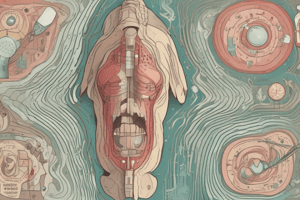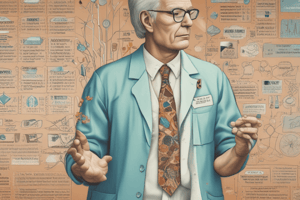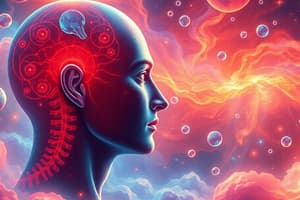Podcast
Questions and Answers
Why are NSAIDs and acetaminophen often favored in initial pain management strategies?
Why are NSAIDs and acetaminophen often favored in initial pain management strategies?
- They possess a high risk of physical dependence, making them suitable for chronic pain.
- They bypass the need for dosage adjustments, simplifying treatment.
- They directly target opioid receptors, providing faster relief.
- They effectively manage mild to moderate pain with a lower risk of dependence, complemented by antipyretic properties. (correct)
What is the most important consideration when administering acetylcysteine for acetaminophen overdose?
What is the most important consideration when administering acetylcysteine for acetaminophen overdose?
- Administering it only if the patient has a history of liver disease.
- Administering it only if the patient is already showing signs of liver damage.
- Administering it as soon as possible after recognizing the overdose. (correct)
- Administering it regardless of when the overdose occurred.
In the context of pain management, what characterizes neuropathic pain?
In the context of pain management, what characterizes neuropathic pain?
- Pain resulting from tissue damage, like a cut or burn.
- Pain that is always acute and short-lived.
- Pain caused by inflammation, such as in arthritis.
- Pain arising from nerve damage or dysfunction. (correct)
How does aspirin's mechanism of action differ from that of second-generation NSAIDs like celecoxib?
How does aspirin's mechanism of action differ from that of second-generation NSAIDs like celecoxib?
Which statement accurately describes a key distinction between opioids and non-opioid analgesics?
Which statement accurately describes a key distinction between opioids and non-opioid analgesics?
Why should patients be educated about the risks of combining acetaminophen with alcohol?
Why should patients be educated about the risks of combining acetaminophen with alcohol?
A patient with a history of gastrointestinal ulcers is seeking an over-the-counter analgesic. Which of the following would be the least appropriate recommendation?
A patient with a history of gastrointestinal ulcers is seeking an over-the-counter analgesic. Which of the following would be the least appropriate recommendation?
When is aspirin contraindicated for patients based on bleeding risks?
When is aspirin contraindicated for patients based on bleeding risks?
According to the WHO analgesic ladder, when should a combination of acetaminophen and an opioid be considered for pain management?
According to the WHO analgesic ladder, when should a combination of acetaminophen and an opioid be considered for pain management?
What type of pain would NSAIDs most appropriately address?
What type of pain would NSAIDs most appropriately address?
Which statement best describes salicylism?
Which statement best describes salicylism?
What is the significance of understanding the 'pain alphabet' (e.g., OLDCARTS) in pain assessment?
What is the significance of understanding the 'pain alphabet' (e.g., OLDCARTS) in pain assessment?
How does the anti-inflammatory action of NSAIDs contribute to their therapeutic effect?
How does the anti-inflammatory action of NSAIDs contribute to their therapeutic effect?
What information should be included when educating patients receiving pain medication?
What information should be included when educating patients receiving pain medication?
Which type of pain is most closely associated with conditions like sunburn and rheumatoid arthritis?
Which type of pain is most closely associated with conditions like sunburn and rheumatoid arthritis?
What is the rationale behind aiming to restore functionality rather than total pain relief in patients with chronic pain?
What is the rationale behind aiming to restore functionality rather than total pain relief in patients with chronic pain?
How does first-pass metabolism influence the route and dosage of opioid administration?
How does first-pass metabolism influence the route and dosage of opioid administration?
Which of the following best describes the mechanism of action of acetaminophen?
Which of the following best describes the mechanism of action of acetaminophen?
A patient reports experiencing ringing in the ears and headaches after taking high doses of aspirin. What condition is the patient likely experiencing?
A patient reports experiencing ringing in the ears and headaches after taking high doses of aspirin. What condition is the patient likely experiencing?
Which of the following describes how NSAIDs, excluding tramadol and clonidine, primarily alleviate pain?
Which of the following describes how NSAIDs, excluding tramadol and clonidine, primarily alleviate pain?
Flashcards
Define pain
Define pain
Unpleasant sensory/emotional experience with actual/potential tissue damage, described in terms of damage.
Pathophysiology of pain
Pathophysiology of pain
Mechanical, thermal, or chemical stimulation leads to sensory experience of basic pain types.
Nonopioid Analgesics
Nonopioid Analgesics
NSAIDs, differs by ceiling effect, no tolerance, antipyretic properties. Treats mild to moderate pain.
WHO Analgesic Ladder
WHO Analgesic Ladder
Signup and view all the flashcards
Aspirin
Aspirin
Signup and view all the flashcards
Anti-inflammatory effects
Anti-inflammatory effects
Signup and view all the flashcards
Mode of action of Aspirin
Mode of action of Aspirin
Signup and view all the flashcards
Aspirin Adverse Effects
Aspirin Adverse Effects
Signup and view all the flashcards
Aspirin Poisoning
Aspirin Poisoning
Signup and view all the flashcards
Ibuprofen
Ibuprofen
Signup and view all the flashcards
Ibuprofen Adverse Effects
Ibuprofen Adverse Effects
Signup and view all the flashcards
Celecoxib
Celecoxib
Signup and view all the flashcards
Acetaminophen
Acetaminophen
Signup and view all the flashcards
Acetaminophen Adverse Effects
Acetaminophen Adverse Effects
Signup and view all the flashcards
Acetaminophen Med Examples
Acetaminophen Med Examples
Signup and view all the flashcards
Acetaminophen Overdose
Acetaminophen Overdose
Signup and view all the flashcards
Acetaminophen Overdose Antidote
Acetaminophen Overdose Antidote
Signup and view all the flashcards
Acetaminophen Nursing Implications
Acetaminophen Nursing Implications
Signup and view all the flashcards
Study Notes
Pain Treatment Overview
- Pain treatment is presented by Krysia Hudson, Sharon Kozachik, and Nicole Mollenkopf.
Objectives of Pain Treatment
- Describe the roles of NSAID salicylates and acetaminophen in pain management.
- Identify the maximum daily dose for aspirin, acetaminophen, and ibuprofen.
- Define salicylism and salicylate poisoning and describe treatments for salicylate poisoning.
- State the major toxicities of acetaminophen overdose.
- State the antidote for acute poisoning from acetaminophen.
- Identify factors that contribute to accidental and intentional overdose.
- Educate patients on how to decrease the risk of overdose.
- Describe the role of opioids in pain management.
- Explain how the route and dose of an opioid is affected by the first-pass effect.
- Apply knowledge of pharmacology to a patient case scenario.
- Identify sources of individual variation in drug response.
- Explain medication safety considerations for patients prescribed pain medications.
- List important points to include during patient and/or family education.
- Identify signs and symptoms of opioid overdose and appropriate treatment.
- Describe the mechanism of action of medications that treat acute opioid toxicity.
- Apply knowledge of the pharmacology of drugs used to treat drug abuse in a patient case scenario.
Vocabulary: Key Terms in Pain Management
- Enkaphalins, endorphins, dynorphins, opioid.
- Opiate, analgesic, mu, kappa.
- Delta, agonist, antagonist, partial agonist.
- Euphoria, dysphoria, tolerance, physical dependence.
- Abuse, withdrawal syndrome, addiction, salicylism.
- Serotonin syndrome, hypertensive crisis.
Understanding Pain
- Pain is an unpleasant sensory or emotional experience, associated with tissue damage or described in terms of such damage.
- Pain is subjective.
- Pain may affect sleep, thoughts, emotions, and daily activities.
- Pain is the most common symptom causing patients to seek medical care.
Pathophysiology of Pain
- Pain receptors are stimulated in response to mechanical, thermal, or chemical factors, including bradykinin, prostaglandin, leukotriene, histamine, or serotonin.
- Interpretation in the brain leads to a sensory experience.
- The three types of basic pain are nociceptive, inflammatory, and neuropathic.
- Assessment includes rating pain using a pain scale.
- Pain experience is assessed using the Pain alphabet, OLDCARTS, or COLDSPA.
Types of Pain
- Inflammatory pain examples include sunburn and abscess.
- Neuropathic pain examples include MS, neuropathy, and SCI.
- Nociceptive pain examples include cancer, disc herniation, post-op pain, trauma, and childbirth.
Pain Alphabet Explained
- "Q" stands for Quality of Pain.
- "R" stands for Region(s) Where Pain is Located.
- "S" stands for Severity of Pain.
- "T" stands for Timing of Pain.
- "U" stands for what the Pain is Usually Associated With.
- "V" stands for anything that provides Relief from Pain.
- "W" stands for anything that Worsens Pain.
Pharmacology of Pain Management
- Goals of therapy include relieving, preventing, and making pain tolerable, and quickly relieving acute pain.
- Chronic pain management involves establishing goals with the patient; total relief might not be realistic, aim is restoring functionality.
Drug Selection: WHO Analgesic Ladder
- Provides a strategy for escalating analgesic therapy.
- Step 1 involves acetaminophen or NSAIDs.
- Step 2 involves acetaminophen + opioid or ASA + opioid.
- Step 3 involves increasing doses of potent opioids +/- adjuvant therapy.
Drugs to Treat Pain
- Non-opioid Analgesics: NSAIDs like salicylates (aspirin) and ibuprofen, second-generation NSAIDs like celecoxib, and analgesics like acetaminophen.
- Opioids: Pure Opioid Agonists like morphine and fentanyl.
- Opioids (cont.): Methadone, meperidine, codeine, oxycodone.
- Agonist-antagonist Opioids: Pentazocine, antagonists include Naloxone.
- Miscellaneous Pain Medications: migraine (sumatriptan, ergotamine), anti-gout (colchicine, allopurinol).
Key Drug Categories
- Non-opioids
- Opioids
- Miscellaneous migraine and gout medications.
Nonopioid Analgesics
- Differ from opioids due to their ceiling effect.
- Characterized by no tolerance, and no physical or psychological dependence.
- Have antipyretic properties.
- Their primary mechanism prevents the formation of prostaglandins by inhibiting the COX enzyme, except for tramadol and clonidine.
- Used to treat mild to moderate pain.
Types of Nonopioid Analgesics
- NSAIDs: First generation (salicylates like aspirin, ibuprofen), second generation (celecoxib).
- Acetaminophen (Tylenol).
Aspirin and NSAIDs: Action Mechanism
- Gastric protection, vasodilation.
- Maintains renal support and vasodilation.
- Platelet aggregation.
- Vasodilation, inflammation, pain.
- Colorectal cancer promotion.
Aspirin and NSAIDs: Mechanisms of Action
- Aspirin: Irreversibly inhibits both COX-1 and COX-2 enzyme, and is OTC.
- First generation NSAIDs: Reversibly inhibit both COX-1 and COX-2, including ibuprofen, naproxen, and ketoprofen available OTC.
- Second generation NSAIDs: Reversibly inhibit only COX-2, Rx only.
ASA/NSAIDs: Therapeutic Uses
- Analgesic, effective for mild to moderate pain.
- Treats inflammatory disorders like dysmenorrhea and osteoarthritis.
- It can be synergistic with opioids.
- Antipyretic, reduces fever by inhibiting prostaglandin formation caused by infection-induced interleukin I release.
Therapeutic Uses of ASA/NSAIDs
- Include anti-inflammatory effects and the ability to block prostaglandins responsible for inflammation.
- Aspirin ONLY inhibits thromboxane A2 and prostacyclin-mediated platelet aggregation.
- ASA and NSAIDs prevent MI/stroke.
- Thromboxane activity is inhibited for the life of the platelet (8 days).
- Prostacyclin is inhibited for several hours.
Individual Variation Factors with Aspirin/NSAIDs
- Hypersensitivity to any Aspirin/NSAID.
- A history of GI intolerance or ulcers.
- Renal dysfunction and bleeding disorders.
- Pregnancy.
- Drug interactions (Warfarin, heparin, glucocorticoids).
Aspirin: Adverse Effects
- Gastrointestinal issues, including distress, heartburn, and nausea, plus occult bleeding.
- Bleeding, contraindicated for patients with bleeding disorders.
- Renal impairment is possible, but acute and reversible.
- Reye’s Syndrome can occur.
- Adverse effects during pregnancy.
- Hypersensitivity, which is contraindicated.
- Salicylism (tinnitus, sweating, headache, and dizziness).
Aspirin Poisoning: Safety Concerns
- Overdose is a common cause of salicylism.
- Symptoms include respiratory alkalosis progressing to respiratory depression, acidosis, hyperthermia, sweating, dehydration, electrolyte imbalance, coma, and death.
- Treatment: Supportive measures such as pumping the stomach, activated charcoal, cooling, administering fluids, and bicarbonate IV.
Ibuprofen: Action and Use
- Ibuprofen reversibly inhibits COX1 and COX2.
- Ibuprofen provides therapeutic action for inflammatory conditions, causing pain, and fever.
Ibuprofen (Motrin®, Advil®): Adverse Effects
- Gastrointestinal: distress, heartburn, nausea, occult bleeding.
- Renal impairment, cross-hypersensitivity to aspirin, and adverse effects during pregnancy.
- Cardiovascular risk and Stevens-Johnson Syndrome (SJS).
- Maximum amount/day: OTC (1200mg/day), prescription (3200mg/day).
Celecoxib (Celebrex®): Action and Adverse Effects
- Celecoxib inhibits COX2 with therapeutic action for osteoarthritis and acute pain.
- Adverse Effects: GI distress, heartburn, nausea, occult bleeding, CV risk, renal impairment, hypersensitivity to aspirin, sulfonamide allergy, and AEs during pregnancy.
Acetaminophen (Tylenol®): Action and Dosage
- Inhibits COX in the CNS only.
- Therapeutic uses include analgesic and antipyretic effects.
- Dosage: 325 mg – 1,000 mg every 4-6 hours for adults.
- Max dose: 4,000 mg per day for adults; outpatient recommended max dose is 3,000 mg/day.
Acetaminophen (Tylenol®): Adverse Effects
- Well tolerated at normal doses, but rare anaphylaxis reactions, skin reactions, and acute hepatotoxicity at doses over 4 g/day.
Medications Containing Acetaminophen
- Over-the-counter: Excedrin, Midol, Nyquil.
- Prescription: Hydrocodone, Tylox, Percocet.
Acetaminophen: Overdose Toxicity
| Stage | Time | Toxicity |
|---|---|---|
| 1 | Within 24 hours | GI symptoms |
| 2 | 24-72 hours | Liver toxicity manifestations (RUQ pain, increased bilirubin, prothrombin time, liver enzymes) |
| 3 | 72-96 hours | Liver failure, may be asymptomatic |
| 4 | 14 days post ingestion | Recovery or death |
Acetaminophen Overdose: Emergency Information
- Maryland Poison Control: (800) 222-1222
- Antidote: acetylcysteine (Acetadote® Mucomyst®).
- Administer ASAP after overdose.
- May be considered up to 24 hours after acute ingestion.
Acetaminophen: Nursing Implications
- Max dose is 4,000 mg/day from all sources.
- Do not drink alcohol; 2,000 mg per day maximum if consuming alcohol.
- Avoid with liver disease and caution about combination products.
Studying That Suits You
Use AI to generate personalized quizzes and flashcards to suit your learning preferences.




